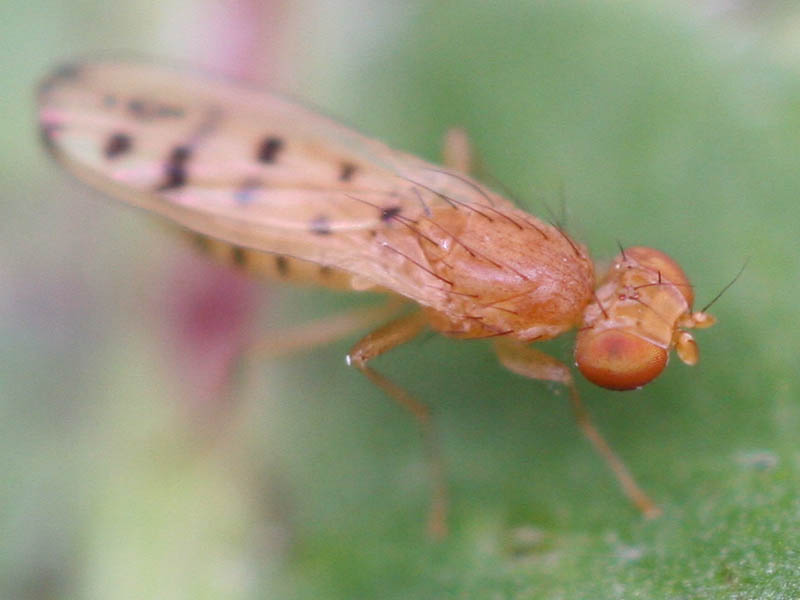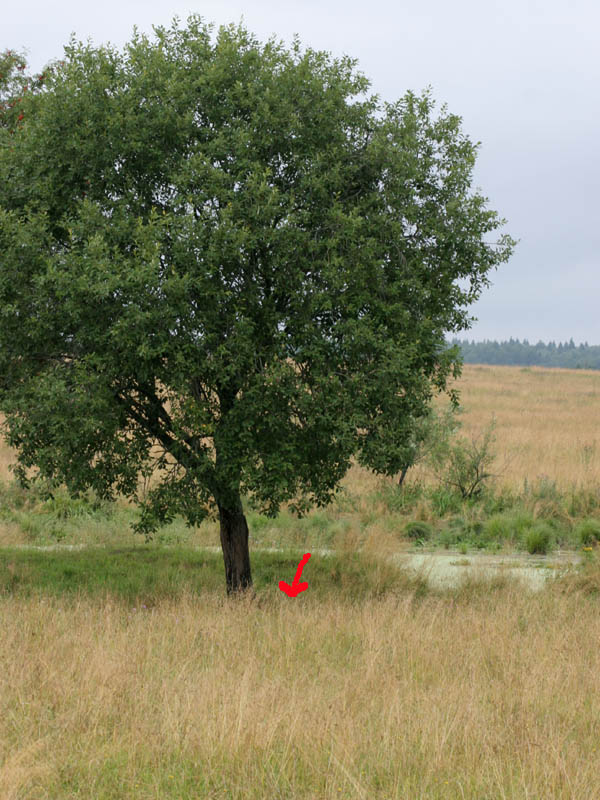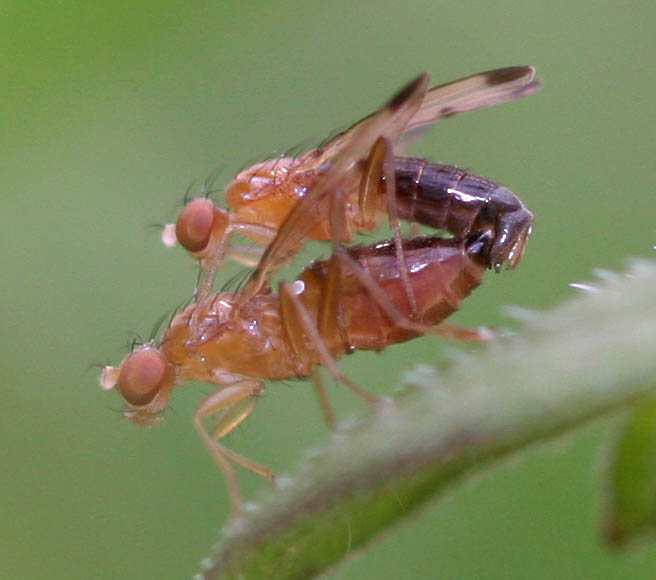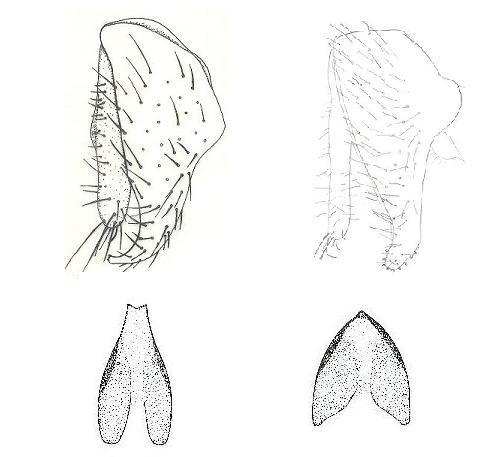Diptera.info :: Miscellaneous :: General queries
|
Opomyzidae
|
|
| Nikita Vikhrev |
Posted on 04-08-2006 13:11
|
|
Member Location: Moscow, Russia Posts: 9513 Joined: 24.05.05 |
Trying to find G. apicalis, found O. punctella. Is it known how Opomyzidae put eggs in plants? As far as I can see they haven't Tephritidae-like long and sharp ovipositor.
Nikita Vikhrev attached the following image:  [45.84Kb] Edited by Nikita Vikhrev on 12-08-2006 07:33 Nikita Vikhrev - Zool Museum of Moscow University |
|
|
|
| Jan Willem |
Posted on 04-08-2006 13:50
|
|
Member Location: Waalwijk, The Netherlands Posts: 2161 Joined: 24.07.04 |
Hi Nikita, If I was looking for Geomyza apicalis and found Opomyza punctella instead, I would be rather excited! Great find! I already told you that G. apicalis is rather scarce in collections. Well, O. punctella even more so! As far as ovipositing concerns, I have no idea about it. I will try if I can find anything about it in my opomyzid literature this weekend! Jan Willem |
|
|
|
| Louis Boumans |
Posted on 04-08-2006 23:59
|
|
Member Location: NO Oslo Posts: 269 Joined: 09.06.04 |
Dear Nikita & Jan Willem, I think the mother lay the eggs on the outer surface of the shoot, and after hatching the larvae enter the tissue. Here you find this described for O. florum: http://www.hgca.c...dia_id=167 I've never seen this myself, but last year I had sown leek (Allium porrum) in my garden, and found the eggs of the Anthomyiid - forgot its name - that destroys the leek plants; likewise on the outer surface of the shoot, near the stem. cheers, Louis Edited by Louis Boumans on 04-08-2006 23:59 |
|
|
|
| Nikita Vikhrev |
Posted on 05-08-2006 08:16
|
|
Member Location: Moscow, Russia Posts: 9513 Joined: 24.05.05 |
Thank you Louis. At least it explains why Opomyzidae are exclusively linked to Poaceae family plants and can't use Asteraceae, for example, as Tephritidae do. Nikita P.S. And one more question to Jan, how to distinguish sexes in Opomyzidae during field observations? Nikita Vikhrev - Zool Museum of Moscow University |
|
|
|
| Jan Willem |
Posted on 05-08-2006 10:05
|
|
Member Location: Waalwijk, The Netherlands Posts: 2161 Joined: 24.07.04 |
Hi Nikita, Louis is right: Brunel in "Manual of Palaearctic Diptera, Volume 3": The eggs are deposited at the base of stems near the soil, generally one egg per plant. Larvae penetrate the leaves and reach the heart of the plant. The developtment of the larvae causes damage referred to as "dead heart". External leaves remain green, central leaves turn yellow and die. At the end of development, which takes 28 to 40 days, the larvae leave the plant and pupate on the surface of the soil. Pupal development takes 20 to 30 days. SOme flies are also able to develop in winter. According to Brunel, the adults can live for a period of three to six month. And Nikita, on how to distinguish the sexes, I can only say, look at the tip of the abdomen! In females the cerci should be clearly visible, making the abdominal tip look rather pointed. Just have a closer look at a few specimens and you will see that the sexes are quite easy to distinguish in Opomyzidae. Jan Willem |
|
|
|
| Nikita Vikhrev |
Posted on 05-08-2006 14:16
|
|
Member Location: Moscow, Russia Posts: 9513 Joined: 24.05.05 |
Thank you Jan. For you - new O. punctella location  Nikita Nikita Vikhrev attached the following image:  [120.68Kb] Nikita Vikhrev - Zool Museum of Moscow University |
|
|
|
| Jan Willem |
Posted on 05-08-2006 16:07
|
|
Member Location: Waalwijk, The Netherlands Posts: 2161 Joined: 24.07.04 |
Hi Nikita, Well thank you very much!  But I have to admit that making pictures of the places where I collect Opomyzidae is actually a very good idea. Jan Willem |
|
|
|
| Nikita Vikhrev |
Posted on 11-08-2006 23:06
|
|
Member Location: Moscow, Russia Posts: 9513 Joined: 24.05.05 |
Now I understand much better how to distinguish sexes in Opomyzidae!
Nikita Vikhrev attached the following image:  [41.07Kb] Nikita Vikhrev - Zool Museum of Moscow University |
|
|
|
| jorgemotalmeida |
Posted on 11-08-2006 23:41
|
|
Member Location: Viseu - PORTUGAL Posts: 9296 Joined: 05.06.06 |
Nikita Vikhrev wrote: Now I understand much better how to distinguish sexes in Opomyzidae!  It is much more easy, indeed!  One picture says a thousand words?  Where can I find these flies? I had seen almost 30 families of flies, so far. Can I see here about 40?N latitude? I am near a river, near 2 mountains  , not so far from marine coast (about 90 km), have a thousand of Pinus sp. around as well olive trees. (and a lot of real fruit trees , not so far from marine coast (about 90 km), have a thousand of Pinus sp. around as well olive trees. (and a lot of real fruit trees  |
| Nikita Vikhrev |
Posted on 12-08-2006 07:51
|
|
Member Location: Moscow, Russia Posts: 9513 Joined: 24.05.05 |
1. I edited the thread's name, because this couple isn't Opomyza, but Geomyza hackmani. 2. Early june I did my best to find any Opomyzidae in Turkey, but without succes. In Sochi (Black sea) I found Opomyzidae even mid November. In Moscow region Aug-Sept seems to me the best month for Opomyzidae (also I found some in early May and late July). My test, best place is pasture sites with low (eated by cows, or splay, or slightly trampled down), but green grass. Than, sit still long enought and you will see them, lookink and acting like Sepsidae, but more flegmatic. Nikita Nikita Vikhrev - Zool Museum of Moscow University |
|
|
|
| Jan Willem |
Posted on 12-08-2006 11:02
|
|
Member Location: Waalwijk, The Netherlands Posts: 2161 Joined: 24.07.04 |
Hi Nikita, For as far as I can judge from your really great picture, these specimens are not Geomyza hackmani but Geomyza balachowskyi! This would be interesting indeed because I doubt if G. balachowskyi is already known from the Moscow region! Have you collected these specimens? If not, please do your best to collect some! I think of the "combinata-group", G. hackmani will probably be most frequent in the Moscow region. About where to find Opomyzidae, my experience is that you can find them almost everywhere in locations with grass. However you must either be patient like Nikita explains or go with your net very low through the vegetation. In my experience in The Netherlands I hardly ever collect Opomyzidae by hand before May. However pitfall traps show that they can be found in early March till late December. I have no records from January and February but I know other people interested in Opomyzidae have seen Opomyzidae in copula in February! Some species are just hardly collected by hand, but very easily by means of pitfall traps. Jan Willem |
|
|
|
| Kahis |
Posted on 12-08-2006 13:36
|
|
Member Location: Helsinki, Finland Posts: 1999 Joined: 02.09.04 |
Jan Willem wrote: About where to find Opomyzidae, my experience is that you can find them almost everywhere in locations with grass. However you must either be patient like Nikita explains or go with your net very low through the vegetation. In my experience in The Netherlands I hardly ever collect Opomyzidae by hand before May. However pitfall traps show that they can be found in early March till late December. I have no records from January and February but I know other people interested in Opomyzidae have seen Opomyzidae in copula in February! Some species are just hardly collected by hand, but very easily by means of pitfall traps. This is also my experience, but I'd add that open fields are better than dense forests for opomyzids. Of ocurse some species may prefer open and others canopied habitats, but for the largest number of specimens open ground is definitely the place. I have to slightly disagree on the collecting time with you: the best time to find opomyzids in Finland is clearly late summer (ie. right now), but sweep-netting in early spring before new green shoots appears can also be fruitful. Early summer is pretty much dead opomyzid-wise. I have sweep-netted Geomyza tripunctata in late March, which is really early in Finland. Think half a meter of snow on the ground and only hottest southward-opening slopes open. Kahis |
| Nikita Vikhrev |
Posted on 12-08-2006 14:07
|
|
Member Location: Moscow, Russia Posts: 9513 Joined: 24.05.05 |
I havn't got yet the articles, Jan recomended for Geomyza. Please, in short words, how to distinguish hackmani from balachowskyi? Nikita Nikita Vikhrev - Zool Museum of Moscow University |
|
|
|
| Jan Willem |
Posted on 13-08-2006 15:08
|
|
Member Location: Waalwijk, The Netherlands Posts: 2161 Joined: 24.07.04 |
Hi Nikita, Maybe the attached pictures will give you some help (left is G. balachowskyi; right is G. hackmani). Sorry for the bad quality of the pictures! Drake (1993) says: Tips of the surstylar lobes terminate in an inwardly directed finger-like extension. Postnotum yellow, or at least more similar in colour to the rest of the thorax than to the abdomen. Females are not separable .... G. balachowskyi Mesnil Tips of the surstylar lobes curved backwards with a slightly expanded rectangular end. Postnotum obviously darker than the rest of the thorax in all male specimens seen ........ G. hackmani Nartshuk In my experience, the colouration of the postnotum is not a totally reliable character! Furthermore the females are separable by the shape of sternite 8 (see picture). Jan Willem Jan Willem attached the following image:  [27.04Kb] Edited by Jan Willem on 13-08-2006 15:11 |
|
|
|
| Nikita Vikhrev |
Posted on 13-08-2006 15:52
|
|
Member Location: Moscow, Russia Posts: 9513 Joined: 24.05.05 |
Thank you Jan, but your kind reply puts several new questions. 1. I collected for you about 10 cf. Geomyza combinata. But with such a "differences" between this species I see no sence to collect all flies. I think you need copulated pairs, collected and specialy lebeled or at least males only. Correct? 2. Also may be you need its collected in alcohol rather than traditional way? 3. Should we change in our Gallery G. hackmani to cf. G. combinata? Nikita Nikita Vikhrev - Zool Museum of Moscow University |
|
|
|
| Jan Willem |
Posted on 13-08-2006 16:59
|
|
Member Location: Waalwijk, The Netherlands Posts: 2161 Joined: 24.07.04 |
Hi Nikita, Let me try to answer your questions: 1) Once you have some more experience with identifying the specimens of the combinata-group it is not that difficult when studying the terminalia. So you may be right it is not very usefull to collect all specimens you "run into", but I think it is a good idea to collect a few (preferably male and female) if you find them on a new locality. Ofcourse pairs in copula are ideal, but individual specimens (both male and female) can be identified. 2) Both specimens preserved in alcohol or pinned are OK. To study the terminalia, I mostly remove the abdomen and boil it in a 10% KOH solution. 3) I think you should change the name in either cf. hackmani or in spec. combinata-group. If the specimen in the gallery is collected, we will be able to put the definate name to it later. Jan Willem |
|
|
|
| Jump to Forum: |













